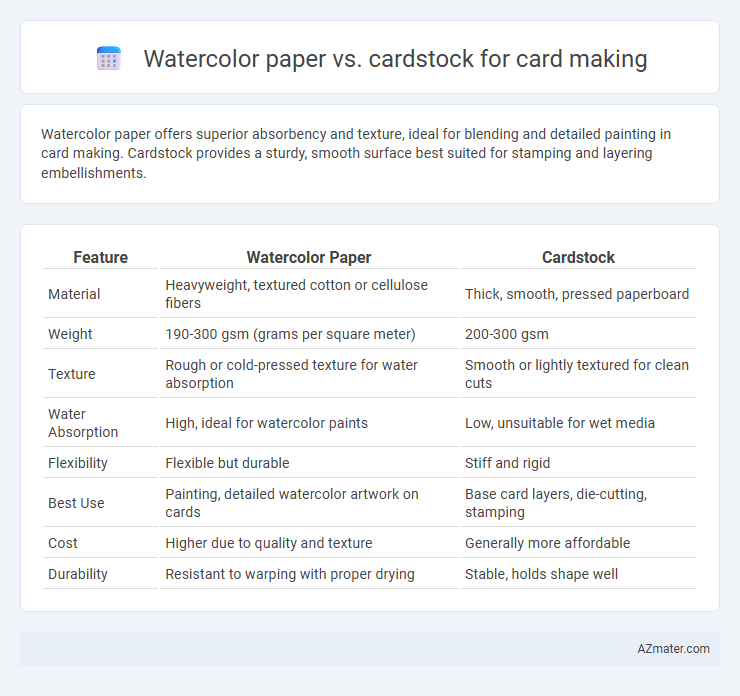Watercolor paper offers superior absorbency and texture, ideal for blending and detailed painting in card making. Cardstock provides a sturdy, smooth surface best suited for stamping and layering embellishments.
Table of Comparison
| Feature | Watercolor Paper | Cardstock |
|---|---|---|
| Material | Heavyweight, textured cotton or cellulose fibers | Thick, smooth, pressed paperboard |
| Weight | 190-300 gsm (grams per square meter) | 200-300 gsm |
| Texture | Rough or cold-pressed texture for water absorption | Smooth or lightly textured for clean cuts |
| Water Absorption | High, ideal for watercolor paints | Low, unsuitable for wet media |
| Flexibility | Flexible but durable | Stiff and rigid |
| Best Use | Painting, detailed watercolor artwork on cards | Base card layers, die-cutting, stamping |
| Cost | Higher due to quality and texture | Generally more affordable |
| Durability | Resistant to warping with proper drying | Stable, holds shape well |
Introduction: Choosing the Right Paper for Card Making
Watercolor paper offers superior texture and absorbency, ideal for vibrant, detailed designs using water-based media. Cardstock provides a sturdy, smooth surface perfect for stamping, layering, and embellishments in card making. Selecting between watercolor paper and cardstock depends on the desired finish, technique, and durability for personalized cards.
Understanding Watercolor Paper: Features and Benefits
Watercolor paper is specifically designed for handling wet media, featuring a textured surface and high absorbency that prevents warping and allows pigments to blend smoothly. Its heavyweight composition, often ranging from 140 lb (300 gsm) and above, ensures durability and resilience when applying multiple watercolor layers. Using watercolor paper for card making enhances color vibrancy and provides a professional finish, making it ideal for artists seeking quality and longevity in their handmade cards.
What is Cardstock? Properties and Common Uses
Cardstock is a thick, durable paper known for its rigidity and smooth surface, making it ideal for card making and crafting projects. With a weight typically ranging from 80 to 110 lb, cardstock offers excellent stability for stamping, embossing, and layering techniques. Common uses include greeting cards, invitations, scrapbooking, and decorative elements due to its versatility and ability to hold ink and embellishments well.
Comparing Thickness and Weight: Watercolor Paper vs Cardstock
Watercolor paper typically ranges from 140 lb (300 gsm) to 300 lb (640 gsm), offering a thicker, more textured surface ideal for absorbing water-based media without warping. Cardstock usually varies between 65 lb (176 gsm) and 110 lb (300 gsm), providing a smoother, lighter base that supports stamping and layering but may buckle with heavy paint. Choosing between the two depends on the desired durability and technique, as watercolor paper offers superior thickness and weight for wet media, while cardstock is more versatile for dry embellishments and crisp folds in card making.
Surface Texture: How It Influences Your Card Designs
Watercolor paper features a textured, absorbent surface ideal for blending and layering water-based paints, creating vibrant and dynamic card designs. Cardstock has a smoother, denser surface that handles inks and markers well, ensuring clean lines and sharp details in card making. Choosing between watercolor paper and cardstock depends on the desired finish: textured vibrancy versus crisp precision in your card artwork.
Suitability for Water-Based Media and Techniques
Watercolor paper is specifically designed to handle heavy water-based media, featuring a textured surface and high absorbency that prevents warping and allows for smooth blending of paints. Cardstock, while sturdy and ideal for stamping or layering, lacks the absorbent quality needed for extensive water use, often leading to buckling and uneven drying. For card making involving techniques like watercolor washes, wet-on-wet, or detailed blending, watercolor paper ensures better durability and enhanced color vibrancy compared to traditional cardstock.
Durability and Longevity: Which Lasts Longer?
Watercolor paper offers superior durability and longevity due to its high cotton content and heavy weight, which resist warping and fading over time, making it ideal for preserving detailed artwork on cards. Cardstock, while sturdy and versatile, tends to be more prone to bending, yellowing, and deterioration, especially when exposed to moisture or sunlight. For card making projects that prioritize lasting quality and archival properties, watercolor paper generally outperforms cardstock in maintaining structural integrity and vibrant appearance.
Printability and Writing Compatibility
Watercolor paper offers superior printability with its textured surface that holds ink without bleeding, making it ideal for vibrant, detailed card designs. Cardstock provides a smooth finish that supports crisp text and fine lines, ensuring clean, professional printing results. When it comes to writing compatibility, watercolor paper can absorb ink unevenly due to its fiber content, while cardstock delivers consistent ink adherence suitable for various pen types and handwriting styles.
Cost and Accessibility: Budget Considerations
Watercolor paper typically costs more than cardstock due to its specialized texture and weight designed to absorb water without warping, making it a premium choice for card making. Cardstock is more budget-friendly and widely accessible at craft stores, providing a sturdy base for cards without the higher expense of watercolor paper. For those prioritizing cost-effectiveness and ease of purchase, cardstock offers a practical option without compromising the quality of handmade cards.
Final Thoughts: Making the Best Choice for Your Cards
Watercolor paper offers superior texture and absorbency, ideal for vibrant color blending and detailed artwork in card making. Cardstock provides a sturdy, smooth surface perfect for stamping, layering, and adding embellishments with durability. Choosing between watercolor paper and cardstock depends on your desired artistic effect and the card's intended use, balancing texture, weight, and finish for the best final presentation.

Infographic: Watercolor paper vs Cardstock for Card making
 azmater.com
azmater.com